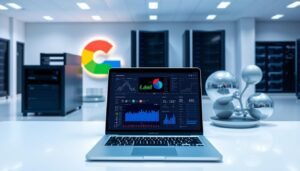In today’s fast-paced world, businesses rely heavily on information to make smart decisions. Two key types stand out: big and small data. While both are valuable, they serve different purposes. Big data helps uncover large-scale trends, while small data reveals the emotional “why” behind customer actions.
For example, the Lego turnaround story highlights how small data provided insights into customer emotions. On the other hand, big data tools process vast amounts of information to identify patterns. The challenge lies in balancing both to drive effective strategies.
This article explores the benefits and challenges of each approach. It also provides real-world examples to help you decide which type matters more for your business. Let’s dive in and uncover the power of data in shaping modern decisions.
Key Takeaways
- Big data identifies large-scale trends and patterns.
- Small data reveals the emotional reasons behind customer behavior.
- Both types are essential for making informed business decisions.
- Real-world examples, like Lego, show the impact of small data.
- Balancing big and small data is key to effective strategies.
Defining Big and Small Data
Different types of datasets play unique roles in shaping business strategies. To harness their full potential, it’s important to understand what sets them apart. Let’s explore the definitions, benefits, and challenges of both big and small datasets.
What is Big Data?
Big data refers to vast and complex datasets that are difficult to process using traditional methods. It’s characterized by the 4Vs: volume, velocity, variety and veracity. These datasets often range from terabytes to exabytes in size and come from diverse sources like social media, sensors, and transaction records.
For example, social media platforms generate massive amounts of information every second. This data helps businesses identify trends and patterns. However, the challenge lies in managing and analyzing such large volumes effectively.
What is Small Data?
Small data, on the other hand, focuses on manageable and high-quality datasets. These are often smaller in scale but provide immediate insights. Examples include monthly sales reports, customer feedback, or observational clues from everyday interactions.
Small data is particularly useful for understanding the “why” behind customer behavior. It’s easier to interpret and doesn’t require advanced tools for processing. This makes it a valuable resource for quick decision-making.
| Aspect | Big Data | Small Data |
|---|---|---|
| Volume | Massive (terabytes to exabytes) | Manageable (megabytes to gigabytes) |
| Velocity | High-speed generation | Slower, more controlled |
| Variety | Diverse sources (text, images, videos) | Structured and focused |
| Veracity | Mixed quality, requires cleaning | High quality, reliable |
“Big data tells you what’s happening, but small data explains why.”
Understanding the differences between these two types of datasets is crucial. While big data helps uncover correlations, small data provides the context needed to understand causation. Together, they offer a comprehensive view for making informed decisions.
Key Differences: Volume, Velocity, and Variety
Understanding the core differences between datasets can transform how businesses operate. Volume, velocity, and variety are the three pillars that define modern datasets. Each plays a unique role in shaping strategies and driving decisions.
Understanding Data Volume
Volume refers to the sheer amount of information generated. For instance, social media platforms produce terabytes of content daily. This massive scale requires advanced storage and processing systems to handle efficiently.
Managing such large datasets can be challenging. However, the insights gained from analyzing them are invaluable. Smaller datasets, while limited in size, offer precise and targeted insights that are easier to interpret.
The Role of Velocity in Data Generation
Velocity describes the speed at which information is created and processed. Real-time data streams from IoT sensors or social media are prime examples. This rapid generation allows businesses to make timely decisions.
For example, monitoring sensor data streams can help predict equipment failures. Smaller datasets, on the other hand, are generated at a slower pace, making them easier to manage and analyze.
Diverse Data Sources and Their Impacts
Variety refers to the different types of information available. Structured data, like databases, and unstructured data, such as social media posts, each offer unique insights. This diversity enhances analytics but also adds complexity.
Customer interactions, for instance, can provide valuable context for decision-making. Smaller datasets, while more homogenous, are simpler to handle and often yield high-quality insights.
“The variety of data types enriches analysis but demands robust tools for effective processing.”
Balancing these three aspects—volume, velocity, and variety—is key to leveraging datasets effectively. While large datasets uncover trends, smaller ones provide the context needed for actionable insights. Learn more about the 5 V’s of big data to deepen your understanding.
Data Quality: Veracity and Value in Insights
Accurate information is the backbone of effective decision-making in any business. The reliability of insights depends heavily on the quality of the datasets used. Whether dealing with massive or smaller datasets, ensuring veracity is critical for actionable results. Ensuring Data Accuracy in Big Data
Handling vast datasets comes with unique challenges. Cleaning and validation techniques are essential to ensure accuracy. For example, removing duplicates and correcting errors can significantly improve the reliability of insights.
Advanced tools like Hadoop and Spark are often used for processing large volumes. These systems help manage the complexity of diverse sources. However, maintaining high standards remains a constant effort.
Leveraging High-Quality Small Data
Smaller datasets are inherently easier to manage. Their structured nature allows for immediate interpretation. This makes them ideal for quick, actionable decisions.
For instance, customer feedback surveys provide direct insights into preferences. These high-quality datasets are often more reliable and require minimal processing. This simplicity is a significant advantage for businesses.
| Aspect | Big Data | Small Data |
|---|---|---|
| Accuracy | Requires extensive cleaning | High from the start |
| Reliability | Mixed, depends on sources | Consistently high |
| Processing | Advanced tools needed | Basic tools sufficient |
| Actionability | Long-term trends | Immediate insights |
“Quality in datasets ensures trust in the insights they provide.”
Balancing the strengths of both types of datasets is key. While massive datasets uncover trends, smaller ones offer the precision needed for immediate action. Together, they create a robust foundation for informed decisions.
Real-World Examples and Use Cases
Real-world datasets show their transformative power in business. From retail to tech, companies use both large and smaller datasets to drive innovation and efficiency. Let’s explore how these approaches shape modern strategies.
Innovative Business Decisions Inspired by Small Data
Small datasets often provide the emotional insights needed for creative solutions. For example, Lego used customer feedback to revamp its product line. By observing how children played, they discovered a preference for simplicity over complexity.
Another example is Lowes Foods, which improved its in-store experience by analyzing customer interactions. These small yet meaningful insights led to tailored strategies that boosted sales and customer satisfaction.

How Big Data Informs Predictive Analytics
Large datasets excel at forecasting trends and identifying patterns. Retail giants like Amazon use vast amounts of information to predict customer preferences. This allows them to stock products efficiently and personalize recommendations.
In healthcare, predictive analytics helps anticipate disease outbreaks. By analyzing diverse sources, organizations can take proactive measures to protect public health. These examples highlight the power of large datasets in shaping long-term strategies.
| Company | Dataset Type | Outcome |
|---|---|---|
| Lego | Small | Revamped product line |
| Lowes Foods | Small | Improved customer experience |
| Amazon | Big | Personalized recommendations |
| Healthcare | Big | Disease outbreak prediction |
“The right dataset, whether big or small, can unlock insights that transform businesses.”
These real-world examples demonstrate the complementary nature of both approaches. While smaller datasets provide emotional context, larger ones uncover trends that drive innovation. Together, they create a robust foundation for informed decisions.
Implementing big data and small data in Business Strategy
Effective business strategies today rely on a blend of large-scale analytics and personal insights. By combining these approaches, companies can uncover both trends and the emotional drivers behind customer behavior. This dual focus ensures decisions are both data-driven and deeply human.
Integrating Data-Driven Approaches for Customer Insight
To understand customers fully, businesses must merge quantitative and qualitative methods. For example, retail giants analyze purchase patterns to identify trends. At the same time, they gather feedback to understand why customers make specific choices.
This combination allows companies to tailor their strategies effectively. Tools like sentiment analysis and surveys provide the emotional context needed to complement hard numbers. Together, these methods create a complete picture of customer behavior.
Balancing Quantitative Analysis with Consumer Emotion
Balancing numbers with emotions is key to successful strategies. While large datasets reveal trends, smaller ones explain the “why” behind actions. For instance, a company might use analytics to spot a drop in sales but rely on customer interviews to uncover the reason.
Case studies like Lowes Foods show how this balance works in practice. By observing customer interactions, they improved in-store experiences. This approach led to higher satisfaction and increased loyalty.
Approach <th>Big Data
| Small Data | ||
|---|---|---|
| Focus | Trends and patterns | Emotional insights |
| Tools | Hadoop, Spark | Surveys, interviews |
| Outcome | Long-term strategies | Immediate improvements |
“The best strategies combine the scale of big data with the depth of small data.”
By aligning these approaches with business goals, companies can make smarter decisions. Whether it’s predicting trends or understanding emotions, the right balance drives success. Start integrating these methods today to unlock the full potential of your strategy.
Tools and Technologies: From Hadoop to Excel
Choosing the right tools for analyzing information can make or break a company’s strategy. Whether dealing with vast datasets or smaller, focused ones, the technology you use plays a critical role. This section explores the advanced and user-friendly solutions available for processing and interpreting different types of information. Advanced Tools for Big Data Processing
Handling large datasets requires robust frameworks. Tools like Hadoop and Apache Spark are designed to manage massive volumes efficiently. These platforms allow businesses to process diverse sources, from social media feeds to sensor outputs, uncovering valuable trends.
For example, Hadoop clusters can analyze terabytes of information in real-time. This capability is essential for industries like e-commerce, where understanding customer behavior drives success. However, these tools often require significant technical expertise and resources.

User-Friendly Solutions for Small Data Analysis
For smaller datasets, simpler tools like Excel and Tableau are often sufficient. These platforms are cost-effective and easy to use, making them ideal for quick insights. For instance, a company might use Excel to analyze monthly sales reports or customer feedback.
SQL is another popular choice for structured datasets. It allows businesses to query information efficiently, providing actionable insights without the need for advanced infrastructure. These tools are perfect for companies looking to make immediate, data-driven decisions.
| Tool | Best For | Complexity |
|---|---|---|
| Hadoop | Large-scale processing | High |
| Excel | Quick analysis | Low |
| Tableau | Visualization | Medium |
“The right tool simplifies analysis, turning raw information into actionable insights.”
Selecting the appropriate technology depends on your company’s needs. Advanced tools offer depth, while simpler solutions provide speed and ease of use. By understanding the strengths of each, businesses can optimize their strategies and stay ahead of the competition.
Challenges and Considerations in Data Processing
Processing information effectively is a cornerstone of modern business success. However, managing datasets comes with its own set of hurdles. From technical limitations to ethical concerns, businesses must navigate these challenges to unlock valuable insights.
Addressing Complexity and Quality Issues
One of the biggest hurdles is handling the sheer complexity of datasets. Large volumes often require advanced systems, while smaller ones demand precision. Ensuring accuracy is critical, as errors can lead to flawed decisions.
For example, incomplete or biased information can skew results. Cleaning and validating datasets are essential steps to maintain quality. This process ensures that the insights derived are reliable and actionable.
Ensuring Security and Compliance
Protecting sensitive information is another major concern. Companies must implement robust security measures to prevent breaches. Compliance with regulations like GDPR is equally important to avoid legal issues.
For instance, healthcare organizations must safeguard patient records. Failure to do so can result in severe penalties and loss of trust. Balancing accessibility with security is key to successful management.
| Challenge | Big Datasets | Small Datasets |
|---|---|---|
| Complexity | High, requires advanced tools | Low, easier to manage |
| Quality | Mixed, needs cleaning | High, reliable |
| Security | High risk, needs robust measures | Lower risk, simpler to protect |
“The right balance of tools and processes ensures smooth and secure management.”
Actionable Advice for Mitigating Issues
To overcome these challenges, businesses should invest in the right technology. Advanced tools like Hadoop are ideal for large volumes, while Excel works well for smaller datasets. Regular audits and training can also improve efficiency.
For example, implementing automated cleaning processes can save time and reduce errors. By addressing these hurdles proactively, companies can unlock the full potential of their information.
Conclusion
Both big and small data play vital roles in shaping modern business strategies. While big data uncovers large-scale trends, small data provides the emotional context behind customer actions. Together, they offer a complete view for informed decision-making.
Real-world examples, like Lego and Amazon, highlight how each type drives success. Tools like Hadoop and Excel cater to different needs, ensuring businesses can process information effectively. Balancing these approaches is key to unlocking actionable insights.
For optimal results, consider a hybrid strategy. Combine the scale of big data with the depth of small data to create a robust foundation. Start integrating these methods today to transform your business strategies.






















4 thoughts on “Understanding Big Data and Small Data: Which One Matters More?”
Wow, marvelous blog layout! How long have you been blogging for? you make blogging look easy. The overall look of your web site is excellent, let alone the content!
As a Newbie, I am always exploring online for articles that can aid me. Thank you
Hello there, You have done an incredible job. I’ll definitely digg it and in my view suggest to my friends. I’m sure they’ll be benefited from this website.
I cling on to listening to the news update lecture about receiving boundless online grant applications so I have been looking around for the finest site to get one. Could you tell me please, where could i get some?